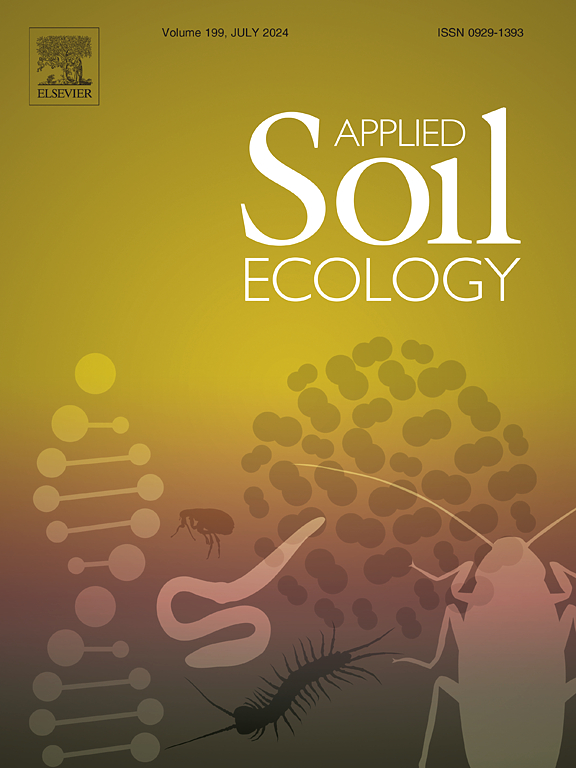树木菌根结合力类型形成亚热带森林甲螨群落
IF 5
2区 农林科学
Q1 SOIL SCIENCE
引用次数: 0
摘要
森林管理优先考虑维持初级生产力和保护生物多样性,其过程受到树木菌根关联及其与土壤动物的相互作用的深刻影响。然而,人们对菌根类型如何构成地下群落知之甚少。本文研究了丛枝菌根(AM)、外生菌根(EM)和混合(AM × EM)树种对亚热带森林生态系统中甲螨群落的影响。通过分析21个样地的环境因子(林冠盖度、凋落物性状、土壤性质)和甲螨群落指标(密度、物种丰富度、功能性状和功能多样性),我们确定了甲螨群落在树木菌根结合力类型中聚集的关键驱动因素。结果表明,AM林分凋落物分解速度快,真菌多样性高,支持具有高δ13C值的食真菌甲螨,表明微生物对碳的利用。相比之下,EM树种在厚且难处理的凋落物层下有利于孤雌生殖物种,这与较高的甲螨密度相关。混合菌根型林分表现出中间性状,表明资源互补性增强了功能冗余。冗余分析表明,冠层盖度、凋落物厚度、土壤真菌多样性和土壤磷是影响甲螨群落结构的重要因素。这些发现表明,菌根类型作为生态过滤器,通过对凋落物化学和微生物相互作用的级联效应塑造土壤动物。我们的研究强调了将菌根多样性纳入森林管理对于在全球变化下维持土壤生物多样性和生态系统恢复力的重要性。本文章由计算机程序翻译,如有差异,请以英文原文为准。
Tree mycorrhizal association types shape oribatid mite communities in a subtropical forest
Forest management prioritizes sustaining primary productivity and conserving biodiversity, with its processes profoundly influenced by tree mycorrhizal associations and their interactions with soil fauna. However, how mycorrhizal types structure belowground communities is poorly understood. Here, we investigated how arbuscular mycorrhizal (AM), ectomycorrhizal (EM), and mixed (AM × EM) tree species influence oribatid mite communities in a subtropical forest ecosystem. By analyzing environmental factors (canopy cover, litter traits, soil properties) and oribatid mite community metrics (density, species richness, functional traits, and functional diversity) across 21 plots, we identified key drivers of oribatid mite community assemblies among tree mycorrhizal association types. Results revealed that AM tree stands, characterized by rapid litter decomposition and high fungal diversity, supported fungal-feeding oribatid mites with high δ13C values, indicating microbial-processed carbon utilization. In contrast, EM tree stands favored parthenogenetic species under thick, recalcitrant litter layers, correlating with higher oribatid mite densities. Mixed mycorrhizal type stands exhibited intermediate traits, suggesting that resource complementarity enhances functional redundancy. Redundancy analysis highlighted canopy cover, litter thickness, soil fungal diversity and soil phosphorus as critical drivers of oribatid mite community structure. These findings demonstrate that mycorrhizal types act as ecological filters, shaping soil fauna through cascading effects on litter chemistry and microbial interactions. Our study underscores the importance of integrating mycorrhizal diversity into forest management to sustain soil biodiversity and ecosystem resilience under global change.
求助全文
通过发布文献求助,成功后即可免费获取论文全文。
去求助
来源期刊

Applied Soil Ecology
农林科学-土壤科学
CiteScore
9.70
自引率
4.20%
发文量
363
审稿时长
5.3 months
期刊介绍:
Applied Soil Ecology addresses the role of soil organisms and their interactions in relation to: sustainability and productivity, nutrient cycling and other soil processes, the maintenance of soil functions, the impact of human activities on soil ecosystems and bio(techno)logical control of soil-inhabiting pests, diseases and weeds.
 求助内容:
求助内容: 应助结果提醒方式:
应助结果提醒方式:


